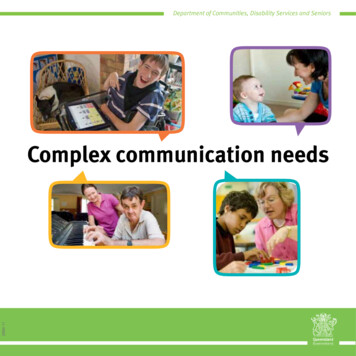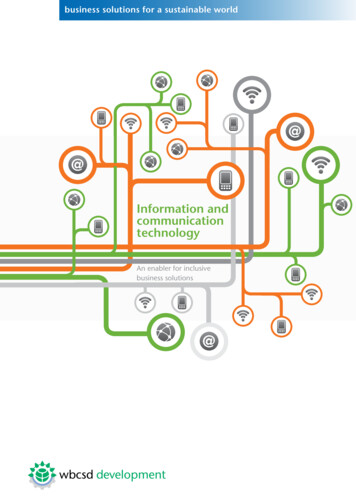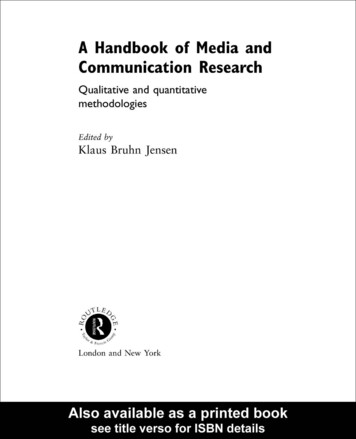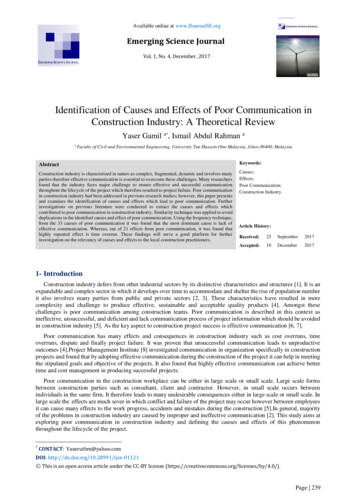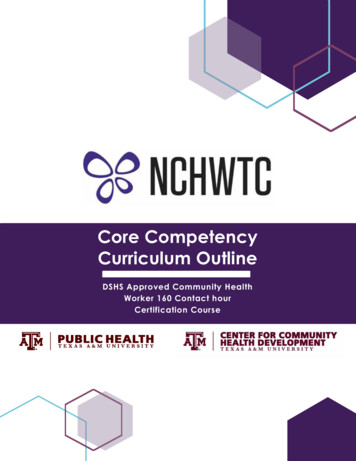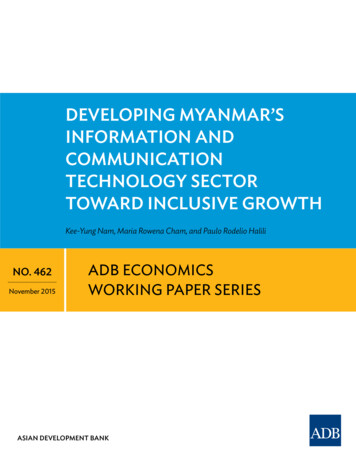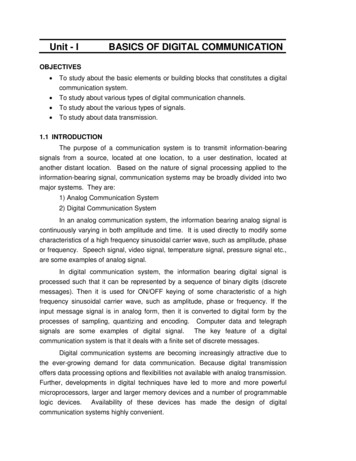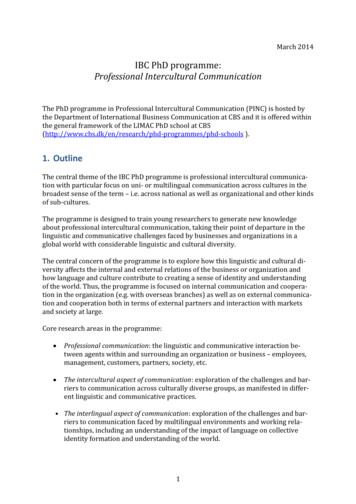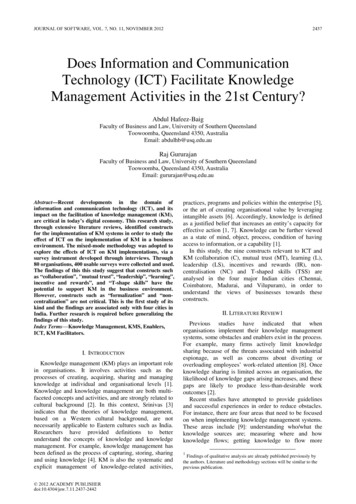
Transcription
JOURNAL OF SOFTWARE, VOL. 7, NO. 11, NOVEMBER 20122437Does Information and CommunicationTechnology (ICT) Facilitate KnowledgeManagement Activities in the 21st Century?Abdul Hafeez-BaigFaculty of Business and Law, University of Southern QueenslandToowoomba, Queensland 4350, AustraliaEmail: abdulhb@usq.edu.auRaj GururajanFaculty of Business and Law, University of Southern QueenslandToowoomba, Queensland 4350, AustraliaEmail: gururajan@usq.edu.auAbstract—Recent developments in the domain ofinformation and communication technology (ICT), and itsimpact on the facilitation of knowledge management (KM),are critical in today’s digital economy. This research study,through extensive literature reviews, identified constructsfor the implementation of KM systems in order to study theeffect of ICT on the implementation of KM in a businessenvironment. The mixed-mode methodology was adopted toexplore the effects of ICT on KM implementations, via asurvey instrument developed through interviews. Through80 organisations, 400 usable surveys were collected and used.The findings of this this study suggest that constructs suchas “collaboration”, "mutual trust”, “leadership”, “learning”,incentive and rewards”, and “T-shape skills” have thepotential to support KM in the business environment.However, constructs such as “formalization” and “noncentralization” are not critical. This is the first study of itskind and the findings are associated only with four cities inIndia. Further research is required before generalizing thefindings of this study.Index Terms—Knowledge Management, KMS, Enablers,ICT, KM Facilitators.I. INTRODUCTIONKnowledge management (KM) plays an important rolein organisations. It involves activities such as theprocesses of creating, acquiring, sharing and managingknowledge at individual and organisational levels [1].Knowledge and knowledge management are both multifaceted concepts and activities, and are strongly related tocultural background [2]. In this context, Srinivas [3]indicates that the theories of knowledge management,based on a Western cultural background, are notnecessarily applicable to Eastern cultures such as India.Researchers have provided definitions to betterunderstand the concepts of knowledge and knowledgemanagement. For example, knowledge management hasbeen defined as the process of capturing, storing, sharingand using knowledge [4]. KM is also the systematic andexplicit management of knowledge-related activities, 2012 ACADEMY PUBLISHERdoi:10.4304/jsw.7.11.2437-2442practices, programs and policies within the enterprise [5],or the art of creating organisational value by leveragingintangible assets [6]. Accordingly, knowledge is definedas a justified belief that increases an entity’s capacity foreffective action [1, 7]. Knowledge can be further viewedas a state of mind, object, process, condition of havingaccess to information, or a capability [1].In this study, the nine constructs relevant to ICT andKM (collaboration (C), mutual trust (MT), learning (L),leadership (LS), incentives and rewards (IR), noncentralisation (NC) and T-shaped skills (TSS) areanalysed in the four major Indian cities (Chennai,Coimbatore, Madurai, and Vilupuram), in order tounderstand the views of businesses towards theseconstructs.II. LITERATURE REVIEW1Previous studies have indicated that whenorganisations implement their knowledge managementsystems, some obstacles and enablers exist in the process.For example, many firms actively limit knowledgesharing because of the threats associated with industrialespionage, as well as concerns about diverting oroverloading employees’ work-related attention [8]. Onceknowledge sharing is limited across an organisation, thelikelihood of knowledge gaps arising increases, and thesegaps are likely to produce less-than-desirable workoutcomes [2].Recent studies have attempted to provide guidelinesand successful experiences in order to reduce obstacles.For instance, there are four areas that need to be focusedon when implementing knowledge management systems.These areas include [9]: understanding who/what theknowledge sources are; measuring where and howknowledge flows; getting knowledge to flow more1Findings of qualitative analysis are already published previously bythe authors. Literature and methodology sections will be similar to theprevious publication.
2438rapidly and freely; reinforcing knowledge with supportiverelationships. Additionally, a review of the literaturereveals that there are many enablers known to influenceknowledge management practices [10]. These enablerscan be broadly classified in either a social or technicalperspective. The social perspective of knowledgemanagement enablers plays an important role and hasbeen widely acknowledged [11]. These enablers arefurther discussed below.One of the enablers is collaboration, an importantfeature in knowledge management adoption. It is definedas the degree to which people in a group actively assistone another in their tasks [12]. A collaborative culture inthe workplace influences knowledge management, as itallows for increased levels of knowledge exchange; aprerequisite for knowledge creation. This is madepossible because a collaborative culture eliminatescommon barriers to knowledge exchange by reducingfear and increasing openness in teams [10].Another enabler is mutual trust. It exists in anorganisation when its members believe in the integrity,character and ability of each other [13]. Trust has been animportant factor in high performance teams as explainedin literature regarding organisational behaviour. Theexistence of mutual trust in an organisation facilitatesopen, substantive and influential knowledge exchange.When team relationships have a high level of mutual trust,members are more willing to engage in knowledgeexchange.A further important enabler is learning. It is defined asany relatively permanent change in behaviour that occursas a result of experience [13]. In organisations, learninginvolves the dynamics and processes of collectivelearning that occur both naturally and in a plannedmanner within the organisation [10].In addition to the above, leadership is often stated to bea driver for effective knowledge management inorganisations [14]. Leadership is defined as the ability toinfluence and develop individuals and teams to achievegoals that have been set by the organisation [13].Adequate leadership can exert substantial influence onorganisational members’ knowledge creation activities.The presence of a management champion for theknowledge management initiative, in order to set theoverall direction for knowledge management programmes,and who can assume accountability for them, is crucial toeffective knowledge management [15].Organisational incentives and rewards that encourageknowledge management activities amongst employeesplay an important role as an enabler [15]. Incentives havethe ability to incite determination or action in employeeswithin an organisation [13]. Rewards, on the other hand,can be broadly categorised as being either extrinsic orintrinsic. Extrinsic rewards are positively valued workoutcomes given to the employee in the work setting,whilst intrinsic rewards are positively valued workoutcomes received by the employee directly, as a result oftask performance [16]. Research supports the view thatboth intrinsic and extrinsic rewards have a positive 2012 ACADEMY PUBLISHERJOURNAL OF SOFTWARE, VOL. 7, NO. 11, NOVEMBER 2012influence on knowledge management performance inorganisations [15].Organisational structure plays an important role as itmay either encourage or inhibit knowledge management.The structure of the organisation impacts the way inwhich organisations conduct their operations and, indoing so, affects how knowledge is created and sharedamongst employees [12]. One enabler for KM is the levelof non-centralisation. This refers to the degree to whichdecision making is non-concentrated at a single point,normally at higher levels of management in theorganisation (Robbins et al. 2001; Wood et al. 1998). Theconcept of centralisation includes only formal authority—that is, rights inherent in one’s position. An organisationis said to be highly centralised if the top managementmakes the organisation’s key decisions with little or noinput from lower level employees [13].Another structural enabler is the level of nonformalisation. It refers to the written documentation ofrules, procedures and policies to guide behaviour anddecision making in organisations [16]. When anorganisation is highly formalised, employees would thenhave little discretion over what is to be done, when it is tobe done and how they should do it, resulting in aconsistent and uniform output [13]. However,formalisation impedes knowledge management activities.This is because knowledge creation requires creativityand less emphasis on work rules. Thus, the range of newideas that emerge from a highly formalized structure islimited.Most teams are composed of individuals who operatefrom a base of deeply specialised knowledge [17]. Theseindividuals need mechanisms in order to translate acrossthe different ‘languages’ that exists in organisations [18].This brings rise to the need for employees with T-shapedskills—that is, skills that are both deep and broad [19].Employees who possess T-shaped skills not only have adeep knowledge of a particular discipline (e.g. financialauditing), but also about how their discipline interactswith other disciplines (e.g. risk analysis, investmentanalysis and derivatives). Iansiti (1993) states that deepknowledge in a particular discipline is aptly representedby the vertical stroke of the ‘T’, whilst knowledge of howthis discipline interacts with other disciplines isrepresented by the horizontal top stroke of the ‘T’ [20].Lastly, but not any less important as an enabler, is ITinfrastructure. It plays an important role in knowledgemanagement. Technology infrastructure includesinformation technology and its capabilities, which areconsidered to assist organisations in getting work done,and effectively managing knowledge that the organisationpossesses [21]. The information technology infrastructurewithin an organisation can be broadly categorised intohardware technologies and software systems. It has beenfound that information technology infrastructure plays acrucial role in knowledge management as it allows foreasy knowledge acquisition and facilitates timelycommunication amongst employees. Informationtechnology infrastructure also speeds up the pace ofknowledge creation and assists in the process of building
JOURNAL OF SOFTWARE, VOL. 7, NO. 11, NOVEMBER 2012organisational memory [22]. These aspects wereinvestigated in this study for their applicability in theIndian context.III. RESEARCH METHODOLOGYA multiple case study was conducted to identify thepossible enablers for organisations when implementingtheir KMS. Twenty organisations were chosen in each ofthe Indian cities: Chennai, Coimbatore, Madurai, andVillupuram. A total number of 80 local and internationalorganisations were interviewed, with focus given to ion. Hence, the unit of analysis is‘organisation’.Four Indian cities were selected based on statistics andintroduction. It is understandable that each of the Indiancities has its unique economic structure, population,history and culture. They cover different economic andgeographic areas. The four cities can then be grouped intotwo main categories for further analysis: metropolitanand regional cities. The metropolitan group includesChennai and Coimbatore, and the regional group includesMadurai and Villupuram. In later sections of this study, itwill be shown that even in the same nation, the results ofdata analysis can vary significantly from one group toanother. Subsequent to the findings of the qualitative datagathered through multiple case studies and modelbuilding, a survey was administered in the same Indiancities in order to examine further, and confirm, the results2439of the case study. The survey either adapted measuresthat had been validated by other researchers, or convertedthe definitions of constructs into a questionnaire. A fivepoint Likert scale was used to measure the extent towhich each factor influenced the respondents’organisations. Opinions from 400 respondents (100 ineach city) in the domain of KMS implementation, with afocus on the enablers of KMS, were collected andanalysed.The nine KM constructs (collaboration (C), mutualtrust (MT), learning (L), leadership (LS), incentives andrewards (IR), non-centralisation (NC) and T-shaped skills(TSS), to the dependent variable InformationCommunications Technologies (ICT) are based on areview of the literature and a multiple case study with 80organisations in four Indian cities. These cities arelocated in metropolitan and regional areas with variouspopulation sizes, social structures and history. Theresearch question addressed in this study can beformulated as follows:Does Information and Communication Technology(ICT) Facilitate Knowledge Management Activities in the21st Century?Based on the literature review, and the results of theIndian case study, the following theoretical model wasconstructed for further investigation. The concepts ofthese factors have been discussed in Section 2.3.Figure 1: Initial research frame work for roles of ICT and KMFrom the above research framework the followingresearch hypotheses can be formulated, and will be testedin this research study. Therefore, on these bases we haveaccepted hypotheses 1, 2, 3, 4 and 5. However, thisresearch has rejected hypotheses 6, 7, 8 and 9. Reasonsbehind this finding might be due to the uniquecharacteristics and social setup of the Indian environmentTABLE 1:SET OF SUMMARY OF HYPOTHESIS ADDRESSED IN THIS RESEARCH PAPERNo.Hypothesis # 1Hypothesis # 2Hypothesis # 3Hypothesis # 4Hypothesis # 5Hypothesis # 6Hypothesis # 7Hypothesis # 8 2012 ACADEMY PUBLISHERHypothesis DescriptionsICT has the potential to support “mutual trust” to facilitate KM in the business environment.Incentives and rewards will have positive effect on the role of ICT in the transformation of KM in thebusiness environment.ICT has the potential to support “incentives and rewards” to facilitate KM in the businessenvironment.ICT has the potential to support “non formalisation” to facilitate KM in the business environment.ICT has the potential to support “collaborations” to facilitate KM in the business environment.ICT has the potential to support “learning” to facilitate KM in the business environment.ICT has the potential to support “leadership” to facilitate KM in the business environment.ICT has the potential to support “non centralisation” to facilitate KM in the business environment.ICT has the potential to support “T-shaped skills” to facilitate KM in the business environment.
2440JOURNAL OF SOFTWARE, VOL. 7, NO. 11, NOVEMBER 2012IV. DATA ANALYSIS AND DISCUSSIONSubsequent to the multiple case studies and modelbuilding, a survey was administered in the same Indiancities to further examine and confirm the results of thecase study. The survey either adapted measures that hadbeen validated by other researchers, or converted thedefinitions of the constructs into a questionnaire. A five-GenderMaleFemaleTotalSeniority2 years or underOver 2 and under 5 yearsOver 5 and under 10 yearsOver 10 yearsTotalpoint Liker scale was used to measure the extent to whicheach factor influenced the respondent’s organisation.Opinions from 400 respondents (100 in each city) in thedomain of KMS implementation, with a focus on theenablers of KMS, were collected and analysed. Theresults of the survey study and hypothesis testing arepresented in this section. Table 6 illustrates thedemographic information of the survey respondents.TABLE II:FREQUENCY DISTRIBUTION OF SURVEYFrequencyPercentageAge Group34285.50%Under 6-60400100%TotalBefore conducting the higher level statistical analysisin order to understand the relationship of the independentdeterminants, Collaboration (C), Mutual Trust (MT),Learning (L), Leadership (LS), Incentives & Rewards(IR), Non-Centralisation (NC) and T-shaped Skills (TSS),to the dependent variable Information CommunicationsTechnologies (ICT), a reliability analysis was 5%23.00%25.50%21.50%10.00%6.25%3.00%1.00%100%on the instrument and the composite variables measuringthe determinants. The instrument value of Cronbach’sAlpha was above 0.9, and according to Hair (2006), sucha value for Cronbach’s Alpha corresponds to a very highvalue of reliability. A summary analysis for thecomposite variable is displayed below:TABLE III:RELIABILITY ual TrustLearningLeadershipIncentives & RewardsNon-CentralizationNon-FormalizationT-shaped SkillsIT .9550.951Cronbach's Alpha Basedon Standardised Before analysing the relationship through theregression analysis, the multicollinearity of the variableswas measured through a correlation analysis. ThroughSPSS, a multiple regression analysis was conductedbetween the independent variables, Collaboration (C),Mutual Trust (MT), Learning (L), Leadership (LS),No. ofItems444444444Incentives & Rewards (IR), Non-Centralisation (NC) andT-shaped Skills (TSS), and the dependent variableInformation Communications Technologies (ICT). Asummary of the regression analysis is provided in thetable below:TABLE IV:SUMMARY OF REGRESSION ANALYSIS AS ATUWT AND AUWTBBetaTSigValueValueValueMutual centives & 046.984.968.965346.9.000T Shape Skills.429.4143.4.001Non 43.9.000Learning.281.2812.2.028Predictors: (Constant), Learning, Collaboration, Leadership, IncentRewards, MutualTrust, Formalisation, TShapeSkills, CentralisationVariables 2012 ACADEMY PUBLISHERRValueR2ValueAdj R2ValueFValueSigLevel
JOURNAL OF SOFTWARE, VOL. 7, NO. 11, NOVEMBER 2012The above table provides strong evidence that variationin ICT is directly related to variation in collaboration (C),mutual trust (MT), learning (L), leadership (LS),incentives and rewards (IR) and T-shaped skills (TSS).The variable non centralisation, however, does notprovide any significant contribution due to variation inICT. The variables T-shaped skills and collaboration arehighly dependent on variation in ICT.The variables mutual trust and incentive and rewardsare negatively loaded, whereas the variables leadership,formulations, T-shaped skills, collaboration and learningare positively related to ICT in the above researchframework. However, collectively there is a very highvariation in the variables such as collaboration (C),mutual trust (MT), learning (L), leadership (LS),incentives and rewards (IR) and T-shaped skills (TSS) as2441they are affected by the ICT infrastructure in a givenorganisation, in the context of knowledge management.On the basis of above data analysis and the relationshipexplored through multiple regression analysis we wereable to accept are reject the above suggested hypothesisespresented in this research study. High level multipleregression analysis suggested constructs as such as“Collaboration” (C); “Leadership” (Led); “Learning”(Ler); “Non-Centralization” (NC); and “T-Shaped Skills”(TSS) are positively related to the role facilitated by theICT infrastructure in a business environment, to facilitateKM activities. However, construct such as “MutualTrust” (MT); “Incentives and Rewards” (IR); and“Formulization” (F) do not have influence or negativelyeffects the role of ICT infrastructure in facilitating theKM in the Indian business environment.TABLE V:SUMMARY OF HYPOTHESIS ACCEPTANCE OR REJECTED IN THIS RESEARCH PAPERNo.Hypothesis DescriptionsAccepted/RejectedICT has the potential to support “Mutual Trust” to facilitateHypothesis # 1KM in the business environmentAcceptedICT has the potential to support “Incentive and Rewards” toHypothesis # 2facilitate KM in the business environmentAcceptedICT has the potential to support “Formalization” to facilitateHypothesis # 3KM in the business environmentRejectedICT has the potential to support “Collaborations” to facilitateHypothesis # 4KM in the business environmentAcceptedICT has the potential to support “Learning” to facilitate KMHypothesis # 5in the business environmentAcceptedICT has the potential to support “Leadership” to facilitateHypothesis # 6KM in the business environmentAcceptedICT has the potential to support “Non Centralization” toHypothesis # 7facilitate KM in the business environmentRejectedICT has the potential to support “T-Shaped Skills” toHypothesis # 8facilitate KM in the business environmentAcceptedFigure II: The results of the regression analysisOn the basis of the above analysis and multipleregression analysis, the above initial research frameworkwas further refined by dropping constructs “NonCentralization” and “Formalization” as these constructsare not significant (p .05). This modifications providedevidences that ICT can play critical role in facilitating theknowledge management constructs, “Collaboration”,Mutual Trust”, “Leadership”, “Learning”, Incentive & 2012 ACADEMY PUBLISHERRewards”, and “ T-Shape Skilled” in a business setting inan Indian environment. This interrelationship can besummarised as follow:What can be inferred from the analysis is that ICT andICT infrastructure can play a critical role in the creation,development, management and sharing of the knowledgeexisting in a business environment. For example,variables such as Collaboration and T-shaped skills in a
2442JOURNAL OF SOFTWARE, VOL. 7, NO. 11, NOVEMBER 2012given organisation can be significantly affected by theICT technologies and ICT infrastructures in thatorganisation. On the other hand, however, variables suchas Mutual Trust and Incentives & Rewards may notdirectly be affected by the ICT technologies or ICTinfrastructure but their presence in the process could havea positive effect on the process of knowledgemanagement in the Indian business environment.streptococcal isolates from a region of hyperendemicity forstreptococcal skin infection and a high incidence ofinvasive infection," Infect Immun, vol. 72, pp. 364-70, Jan2004.H. Lee and B. Choi, "Knowledge management enablers,processes and organisational knowledge: an integrativeview and empirical investigation," Journal of ManagementInformation Systems, vol. 20, pp. 179-228, 2003.S. Robbins, B. Millet, and R. Cacioppe, Organisationalbehaviour: leading and managing in Australia and NewZealand, 3rd ed. Malaysia: Prentice Hall, 2001.M. Khalifa and V. Liu, "Determinants of sccessfulknowledge management programs," Electronic Journal ofKnowledge Management, vol. 1, pp. 103-112, 2003.S.-H. Yu, Y.-G. Kim, and M.-Y. Kim, "LinkingOrganisational Knowledge Management Drivers toKnowledge Management Performance: An exploratorystudy," in 37th Hawaii International Conference on SystemSciences, Hawaii, USA, 2004.J. Wood, J. Wallace, R. Zeffane, J. Schermerhorn, J. Hunt,and R. Osborn, Organisational Behaviour: An Asia-PacficPerspective. Australia: John Wiley, 1998.C. Davvy, "Recipients: the key to information transfer,"Knowledge Management Research and Practice, vol. 4, pp.17-25, 2006.D. Ford and D. Staples, "Perceived value of knowledge:the potential informer's perception," KnowledgeManagement Research and Practice, vol. 4, pp. 3-16, 2006.D. Leonard-Barton, Wellsprings of Knowledge: Buildingand Sustaining the Sources of Innovation. Boston: HarvardBusiness School Press, 1995.M. Iansiti, "Real-world R&D: jumping the productgeneration gap," Harvard Business Review, pp. 138-147,1993.C. Holsapple, "The inseparability of modern knowledgemanagement and computer-based technology," Journal ofKnowledge Management, vol. 9, pp. 45-52, 2005.A. Okunoye and H. Karsten, "ITI as a Enabler ofKnowledge Management: EmpiricalPerspective from Research Organisations in sub-SaharanAfrica," in 35th Hawaii International Conference onSystem Sciences, Hawaii, USA, 2002.[12][13]CONCLUSION AND LIMITATIONSFrom the above analysis it can be concluded that allthe variables Collaboration (C), Mutual Trust (MT),Learning (L), Leadership (LS), Incentives & Rewards(IR), Formalisation and T-shaped Skills (TSS) can playsignificant roles in the lifecycle of the creation,management and sharing of organisational knowledge inthe Indian business environment. To the best knowledgeof the authors this is the first study of its nature exploringthe relationship between the ICT technologies andenablers of knowledge management in the Indianbusiness setting. The data used was limited and furtherresearch is needed before generalising the findings of thisresearch.REFERENCES[1] M. Alavi and D. E. Leidner, "Review: knowledgemanagement and knowledge management systems:conceptual foundations and research issues," MISQuarterly, vol. 25, pp. 107-136, 2001.[2] G.-W. Bock, R. W. Zmud, and Y.-G. Kim, "Behavioralintention formation in knowledge sharing: Examining theroles of extrinsic motivators, social-psychological forces,and organisational climate," MIS Quarterly, vol. 29, pp.87-111, 2005.[3] N. Srinivas, "Mimicry and revival: the transfer andtransformation of management knowledge to India 1959–1990," International Studies of Management andOrganisation, vol. 38, pp. 38-57, 2009.[4] T. H. Davenport and L. Prusak, Working knowledge.Boston: Harvard Business School Press, 1998.[5] W. KM, "Knowledge Management: An Introduction andPerspective," Journal of Knowledge Management, vol. 1,pp. 6-14, 1997.[6] K. Sveiby, The new organisational wealth: managing andmeasuring knowledge-based assets. San Francisco: BerretKoehler Publishers, 1997.[7] G. P. Huber, "Transfer of knowledge in knowledgemanagement systems: unexplored issues and suggestedstudies," European Journal of Information Systems, vol. 10,pp. 72-79, 2001.[8] D. Constant, S. Kiesier, and L. Sproull, "The kindness ofstrangers," Organization Science, vol. 7, pp. 119-135, 1996.[9] R. Emelo, "The future of knowledge management," inChief Learning Officer, 2009, pp. 44-47.[10] G. G. G. Gan, "Knowledge management practices inmultimedia super corridor status companies in Malaysia,"in Business Faculty. vol. Master of Business InformationTechnology: University of Southern Queensland, 2006, p.217.[11] F. C. McKay, J. D. McArthur, M. L. Sanderson-Smith, S.Gardam, B. J. Currie, K. S. Sriprakash, P. K. Fagan, R. J.Towers, M. R. Batzloff, G. S. Chhatwal, M. Ranson, andM. J. Walker, "Plasminogen binding by group A 2012 ACADEMY r. Hafeez-Baig is a Senior Lecturer in theSchool of Information Systems at the USQ,and obtained his Ph.D. in 2010. He haspublishedovertwodozenrefereedpublications in the domains of health andeducation with technology as the main area ofresearch. His research interests are wirelesstechnologies in healthcare, knowledgemanagement, adoption, diffusion, and infusion of informationtechnology.Professor Raj Gururajan currently works atthe School of Information Systems,University of Southern Queensland, Australia.He has over 25 years in teaching, research,consultancy, and a proven track record incompleting a list of funded projects in Healthand Telehealth areas. He has been theAssociated Dean (Research) in the Faculty ofBusiness and Laws and the member of key universitycommittees and other professional organisations. He has morethan 130 peer-reviewed publications, and was awardedExcellent Journal Article Prizes from the major publishers.
knowledge management initiative, in order to set the overall direction for knowledge management programmes, and who can assume accountability for them, is crucial to effective knowledge management [15]. Organisational incentives and rewards that encourage knowledge management activities amongst employees play an important role as an enabler [15].

